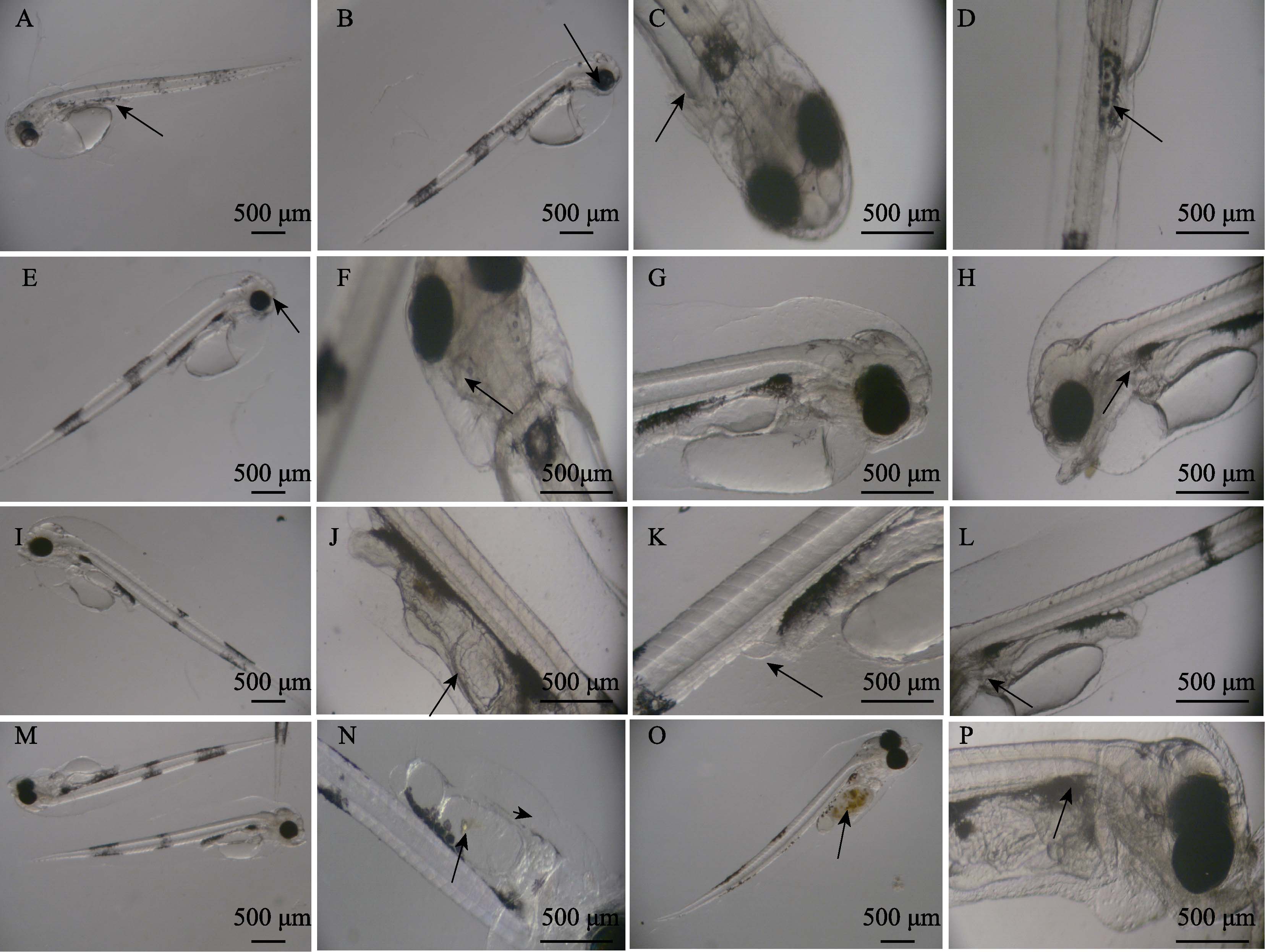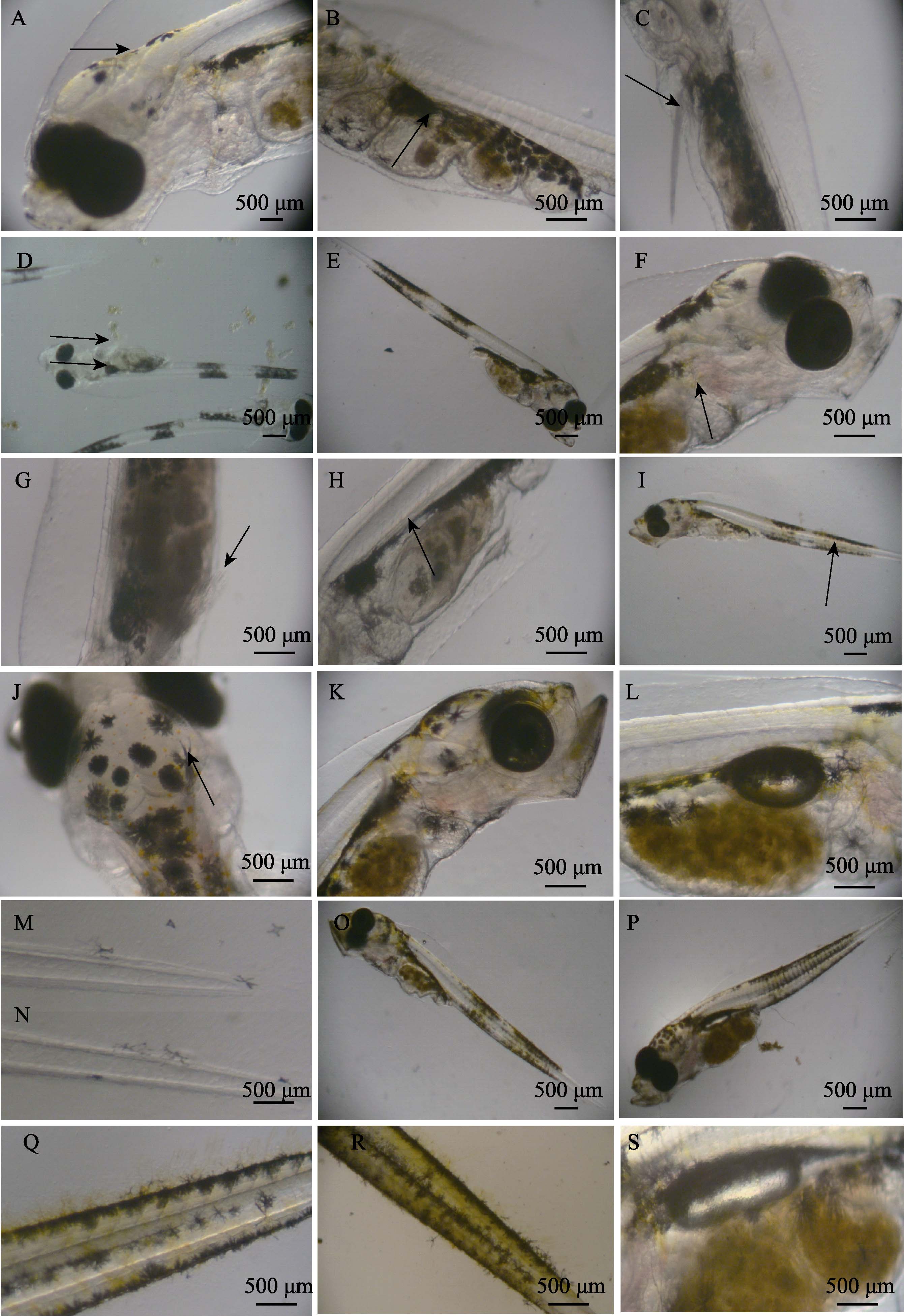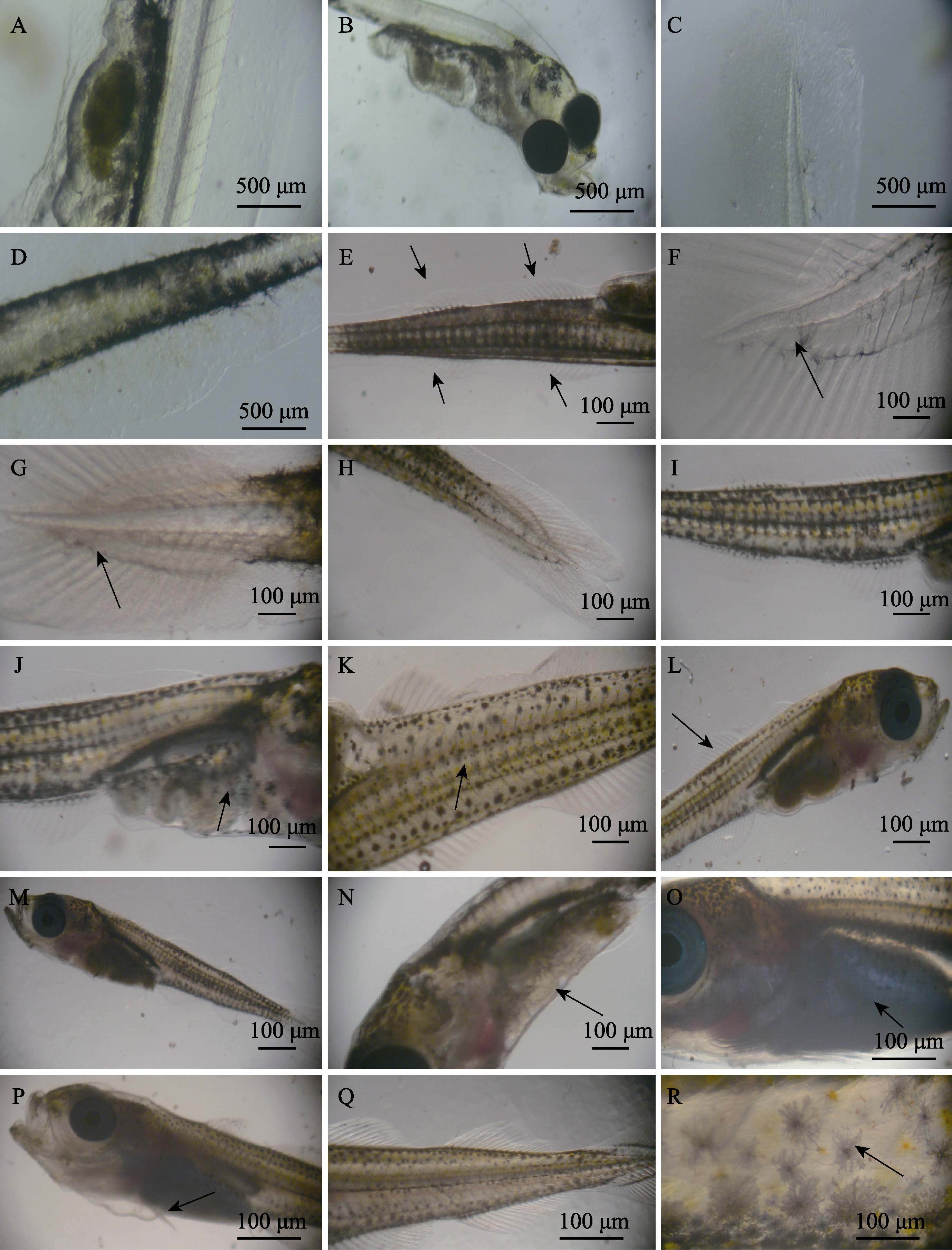2. 上海海洋大学 上海 201306;
3. 山东省海洋生物研究院 青岛 266002
2. Shanghai Ocean University, Shanghai 201306 ;
3. Marine Biology Institute of Shandong Province, Qingdao 266002
太平洋鳕(Gadus macrocephalus Tilesius)又名大头鳕,肉味鲜美、肉质口感好、个体抗病力强,是一种物美价廉的海水鱼类,其资源量较大,是北太平洋(美国、俄罗斯、日本、加拿大、韩国和中国)最主要的渔获种类之一,据FAO统计,近年来太平洋鳕的世界产量在40万t左右。太平洋鳕在我国主要产于黄海,历史上最高产量达2.6万t,其资源量存在周期波动,曾维持较高水平(朱元鼎等,1963; 沈汉祥等,1987),但近年来产量有所下降(高天翔等,2003; 刘名,2010 1))。
1) 刘名. 太平洋鲱和大头鳕的群体遗传学研究. 中国海洋大学博士研究生学位论文, 2010
有关鱼类仔鱼发育的研究由来已久(刘筠,1993; 李恒颂等,2000; 易祖盛等,2002; 谢恩义等,2002; 张开翔,1984; Wei et al,2002),对鱼类仔稚幼鱼的形态特征和生长发育的观察是鱼类资源保护和人工繁育的基础,对鱼类的苗种培育具有重要的指导意义。目前,对太平洋鳕苗种繁育过程中仔鱼发育的研究尚未见详细报道。本研究在太平洋鳕的人工繁殖过程中,详细观察了其不同发育时期仔鱼的形态特征及发育速度,可为太平洋鳕自然资源的开发利用以及深入开展太平洋鳕的工厂化人工育苗和规模化养殖提供基本的参考资料。
1 材料与方法实验于2014年1-4月在山东省日照市福源育苗场进行。在太平洋鳕的人工繁殖和规模化苗种培育过程中,从初孵仔鱼开始,每天从育苗池中随机取样50尾,使用Olympus sz61解剖镜和Nikon TS100显微镜观察仔鱼形态特征,并拍照记录。
仔鱼通过人工授精方法获得,苗种培育条件:水温为2-12℃、盐度为28-32、pH为7.8-8.2,前期微充气静水培养,后期换水并逐渐加大换水量,饵料为褶皱臂尾轮虫(Brachionus plicatilis)和卤虫(Artemia sp.)无节幼体。
根据仔鱼的营养来源将其划分为前期仔鱼期和后期仔鱼期,全长以平均值±标准差(Mean±SD)表示。
2 结果 2.1 前期仔鱼期0 dph(Day post hatching)初孵仔鱼全长为(3.70±0.11)mm。卵黄囊较大、腹位、近头部已经部分被吸收。太平洋鳕鱼卵异率孵化长达7 d左右。初孵仔鱼在水中呈倒悬浮状态,无主动游泳能力,偶尔以卵黄囊为中心,靠尾部迅速摆动螺旋式向上运动;眼球具黑色素,呈现深棕色,眼球下后方可见节律性跳动的心脏,心率为(30±4)次/min;腹腔上壁具黑色素丛,消化道为实心管状(图 1-A);躯干黑色素点状,数量少,不形成色素丛。

|
图 1 太平洋鳕前期仔鱼(0-9 dph)发育 Figure 1 The development of 0-9 dph G. macrocephalus larvae A:初孵仔鱼,消化道(箭头所示)实心管状;B:1 dph仔鱼,色素沉积颜色加深,眼球彩虹色素(箭头所示)出现;C:1 dph仔鱼,胸鳍(箭头所示)出现;D:1 dph仔鱼,消化道末端在体右侧(箭头所示,随机抽取50尾均在同侧);E:2 dph仔鱼,口裂出现(箭头所示);F:2 dph仔鱼,耳石(箭头所示)清晰可见;G:3 dph仔鱼,消化道较2 dph仔鱼进一步膨大;H:3 dph仔鱼,消化道及肝脏膨大(箭头所示);I:4 dph仔鱼,口裂完成,无张合功能;J:4 dph仔鱼,消化道内壁出现褶皱(箭头所示);K:5 dph仔鱼,膀胱(箭头所示)进一步膨大;L:5 dph仔鱼,消化道于肝脏处仍未打通(箭头所示);M:6 dph仔鱼,消化道完全打通;N:6 dph仔鱼,消化道内小颗粒物质(箭头所示);O:9 dph仔鱼,消化道内有轮虫存在;P:9 dph仔鱼,血液循环系统清晰可见(图中箭头示血管) A: Newly hatched larvae,digestive tract(indicated by the arrow)was a solid vessel; B: 1 dph larvae,pigmentation darkened,rainbow pigment appeared in eyeball(indicated by the arrow); C: 1 dph larvae,the pectoral fin appeared(indicated by the arrow); D: 1 dph larvae,the end of the digestive tract was in the right side of the body(indicated by the arrow,the digestive tracts of randomly selected 50 larvae were all in the same side); E: 2 dph larvae,schistostoma appeared(indicated by the arrow); F: 2 dph larvae,the otolith(indicated by the arrow)was visible; G: Digestive tract of 3 dph larvae expanded,comparing with 2 dph larvae; H: 3 dph larvae,digestive tract and liver enlarged; I: 4 dph larvae,schistostoma shaped,but the maxillary,mandible could not move; J: 4 dph larvae,flods appeared in the digestive tract(indicated by the arrow); K: 5 dph larvae,bladder enlarged(indicated by the arrow); L: 5 dph larvae,digestive tract still not canalized beside liver(indicated by the arrow); M: 6 dph larvae,digestive tract canalized completely; N: 6 dph larvae,small particles in the digestive tract(indicated by the arrow); O: 9 dph larvae,rotifera was found in digestive tract; P: 9 dph larvae,blood circulation was visible(blood vessel was indicated by the arrow) |
1 dph仔鱼全长为(3.90±0.15)mm。卵黄囊吸收近1/2,黑色素沉积较初孵仔鱼颜色加深,眼球出现彩虹色素(图 1-B)。仔鱼躯干部形成典型的双段环状色素丛,为鳕鱼属特有的仔鱼形态特征(卞晓东,2010)1)。仔鱼胸鳍出现(图 1-C),可保持身体平衡;消化道未贯通,肛门位于仔鱼鱼体右侧(图 1-D)。
1)卞晓东. 鱼卵、仔稚鱼形态生态学基础研究——兼报黄河口海域鱼类浮游生物调查. 中国海洋大学博士研究生学位论文,2010
2 dph仔鱼全长为(4.20±0.17)mm。卵黄囊进一步吸收,由于不同仔鱼发育速度不同,孵化出膜时间不同。此时,卵黄囊大小不一,有的少于1/2,有的多于1/2;眼球黑色。口裂出现(图 1-E),消化道继续膨大,并向头部和尾部延伸。耳石清晰可见(图 1-F),黑色素分布区开始扩大;心率增加至约50次/min。
3 dph仔鱼全长为(4.30±0.20)mm,卵黄囊进一步缩小,由腹腔内膨大的消化道和肝脏填充(图 1-G,图 1-H)。口裂继续扩大。
4 dph仔鱼全长为(4.40±0.02)mm(图 1-I)。吸收中的卵黄囊呈现不规则形状,残存的卵黄囊边缘明显,卵黄囊逐渐缩小。大部分仔鱼口裂形成,但无张合动作,头部开始出现黄色素带,肠道及肝脏占据腹腔的大部分,肠道内壁出现褶皱(图 1-J)。肛门从体右侧移至腹部正中下方,肛门末端未与外界相通。
5 dph仔鱼全长为(4.60±0.12)mm。膀胱开始膨大(图 1-K),黑色素继续增多。上下颚已具张合能力,部分仔鱼肛门处有蠕动,消化道除近肝脏处仍未打通外,其余部分均已打通(图 1-L)。
6 dph仔鱼全长为(4.60±0.10)mm。仔鱼开口摄食(图 1-M,图 1-N),上下颌张合频率较低,初次摄食对象多为小球藻(Chlorella spp.)及其他小颗粒物质,很少有摄食轮虫的个体出现。
9 dph仔鱼全长为(4.80±0.07)mm。仔鱼上下颌张合频率提高,摄食状况良好,消化道内充满摄食的轮虫,基本保持充盈状态(图 1-O)。色素分布区扩散减慢,呈现出较为清晰的大点状黑色素。血细胞流动清晰可见,卵黄囊基本消失(图 1-P)。
2.2 后期仔鱼期12 dph仔鱼全长为(5.50±0.19)mm。仔鱼摄食旺盛,头部黄色素带明显(图 2-A),包括头颅处及其后的躯干部分,黄色素无特定形状,与黑色素的点状或放射状不同;躯干的黑色素呈雪花状、点状分布(图 2-B),鳍膜基部开始出现黑色素(图 2-C)。鳃盖后缘偶尔可见红色。

|
图 2 太平洋鳕后期仔鱼(12-30 dph)发育 Figure 2 The development of 12-30 dph G. macrocephalus larvae A:12 dph仔鱼,头部处黄色素(箭头所示);B:12 dph仔鱼,躯干部黑色素(箭头所示);C:12 dph仔鱼,胸鳍基部黑色素(箭头所示);D:12 dph仔鱼,消化道内食物(箭头所示);E、F:15 dph仔鱼,黑色素、黄色素呈三条带式,肝脏靠近围心腔(箭头所示);G:15 dph仔鱼,少数仔鱼胸鳍(箭头所示)发生;H:15 dph仔鱼,少数仔鱼鳔器官(箭头所示)发生;I、J:17 dph仔鱼,橘红色素(箭头所示)分布清晰;K:20 dph仔鱼,眼球发育完善,存在反光色素点;L:20 dph仔鱼,鳔器官发育成型;M、N:20 dph仔鱼,尾部色素分布无规律;O:20 dph仔鱼;P:30 dph仔鱼,鳔发育完善;Q、R:30 dph仔鱼,躯干色素向背、腹鳍膜扩散;S:30 dph仔鱼,鳔器官及仔鱼摄食 A: 12 dph larvae,yellow pigment on head(indicated by the arrow); B: 12 dph larvae,melanin on body(indicated by the arrow); C: 12 dph larvae,melanin on pectoral fin(indicated by the arrow); D: 12 dph larvae,feed in the digestive tract(indicated by the arrow); E and F: 15 dph larvae,melanin and yellow pigment spread in three bands and liver near the pericardial cavity(indicated by the arrow); G: 15 dph larvae,pectoral fin developed in a few larvae(indicated by the arrow); H: 15 dph larvae,swim bladder developed in few larvae(indicated by the arrow); I and J: 17 dph larvae,orange pigment(indicated by the arrow)appeared clearly on body; K: 20 dph larvae,eye developed completely and there were reflection points of pigment; L: 20 dph larvae,developed complete swim bladder; M and N: 20 dph larvae,irregular distribution of pigment on the tail; O: The whole larvae body of 20 dph; P: 30 dph larvae,swimming bladder developed completely; Q and R: 30 dph larvae,the pigment migrated from the trunk to the back,and ventral fin membrane diffused; S: 30 dph larvae,swimming bladder and feed intakeing |
15 dph仔鱼全长为(6.80±0.31)mm。黑色素和黄色素密集,主要分布在头部上方、消化道上方和尾部的2个环状区域(图 2-E);肝脏前侧靠近头部的围心腔内,发育中的血细胞呈粉红色,颜色清晰可见(图 2-F)。胸鳍发育较快,已经出现放射条纹(图 2-G)。部分个体鳔内开始充气(图 2-H)。此阶段,仔鱼出现大量死亡现象,在水中极少数仔鱼分布,3 d后水体中才出现仔鱼分布,并由以前的避光聚集变为趋光聚集。
17 dph仔鱼全长为(6.60±0.28)mm。桔红色点状色素颗粒大量分布于头颅上方、鼻孔附近、延髓与脑干连接处,呈点状分布,躯干其他部分的黄色素则无固定形状。此时,躯干有扩散的黄色素带(图 2-I),同时具有黄、红两种点状色素颗粒(图 2-J)。约10%的个体可观察到已充气的鳔。
20 dph仔鱼全长为(9.00±0.32)mm。眼球发育完善,彩虹色素丰富,在照片中可以明显看到大量反光色素点的存在,呈现出蓝色、黄色、绿色等多种色彩(图 2-K-图 2-O)。充盈的消化道已将肝脏挤向腹腔的前下方。腹动脉可观察到明显的血流,血细胞逐步变红,使得围心腔、鳃部呈明显的红色。鱼体尾部色素点开始出现,无规律,不同仔鱼尾部色素点分布情况见图 2-M和图 2-N。
30 dph仔鱼全长为(16.00±2.00)mm。躯干中部黄色素向背部方向延伸至仔鱼鳍膜,仔鱼背鳍鳍膜退化,鳍条开始发育;尾鳍鳍膜出现色素颗粒,以点状为主,无规律,尾鳍鳍条开始发育(图 2-P-图 2-S)。
40 dph仔鱼全长为(22.00±2.20)mm。躯干后部黄色素更加明显,鳍膜在躯干后部有裂口,出现第1、2、3背鳍的雏形;消化道进一步膨大,与躯干比例相对下降,口裂也进一步变大(图 3-A-图 3-D),仔鱼可摄食少量卤虫,摄食量为2-5个。

|
图 3 太平洋鳕后期仔鱼(40-80 dph)发育 Figure 3 The development of 40-80 dph G. macrocephalus larvae A:40 dph仔鱼,消化道内卤虫;B:口裂进一步增大;C:40 dph仔鱼,尾鳍幼鳍膜破裂,开始退化;D:40 dph仔鱼,背鳍幼鳍膜有裂口出现,第1、2、3背鳍开始发生;E:50 dph仔鱼,背鳍和臀鳍(箭头所示)进一步发育;F:50 dph仔鱼,尾椎骨开始上翘(箭头所示);G and H:56 dph仔鱼,尾鳍鳍条进一步发育(箭头所示);I and J:60 dph仔鱼,臀鳍发生,体色趋于完善,鳔器官经过挤压变细长,胆可见(箭头所示); K: 70 dph仔鱼,体内血管清晰可见(箭头所示);L:70 dph仔鱼,背鳍,鳍条清晰可见(箭头所示);M:70 dph仔鱼整体;N: 70 dph仔鱼,腹部出现细小颗粒状反光点(箭头所示),鳞片开始发育;O:80 dph仔鱼,腹部银亮色(箭头所示)更加明显;P:80 dph仔鱼腹鳍(箭头所示)出现;Q:80 dph仔鱼,鳍条发育;R:80 dph仔鱼,体表的黑色素(箭头所示)、黄色素 A: 40 dph larvae,there were Artemia sp. in the alimentary canal; B: 40 dph larvae,schistostoma became bigger; C: 40 dph larvae,the caudal fin membrane was broken and started to degenerated; D: 40 dph larvae,there were chasm in the dorsal fin membrane,indicated the development of the first,second,and third dorsal fin; E: 50 dph larvae,the dorsal fin and anal fin were further developed(indicated by the arrow); F: 50 dph larvae,the coccyx began to warp up(indicated by the arrow); G and H: 56 dph larvae,the tail fin was further developed(indicated by the arrow); I and J: 60 dph larvae,the development of the anal fin,and the body color maturated,swimming bladder became longer and thinner after extruding,gallbladder was visible(indicated by the arrow); K: 70 dph larvae,blood vessels were visible(indicated by the arrow); L: 70 dph larvae,the fin ray of the dorsal fin was clearly visible(indicated by the arrow); M: full view of 70 dph larvae; N: 70 dph larvae,there were reflection points of pigment on the surface of the abdomen(indicated by the arrow),the scales started to appear; O: 80 dph larvae,the reflection points at the abdomen became more obvious(indicated by the arrow); P: the pelvic fin appeared(indicated by the arrow); Q: 80 dph larvae,the development of the fin ray; R: 80 dph larvae,the melanin and yellow pigment on fish(indicated by the arrow) |
50 dph仔鱼全长为(29.00±1.80)mm。色素沉积相对40 dph更加明显,整个躯干部分色素均较深(图 3-E)。尾鳍进一步发育,尾椎骨开始上翘,放射丝少且分散,尾鳍鳍条数量较少但清晰可见(图 3-F),臀鳍、背鳍雏形已清晰可见(图 3-E)。摄食卤虫量增加至8-10个。
56 dph仔鱼全长为(33.00±1.60)mm。尾鳍鳍膜完全褪去,鳍条更加清晰,数量多且收拢密集。尾椎骨上翘程度与50 dph尾椎骨上翘程度相比有所下 降(图 3-G、图 3-H)。
60 dph仔鱼全长为(35.00±1.40)mm。黄色素在脊柱上下两侧呈对称性分布,点状黄色素逐渐变为条带状(图 3-I);黑色素在脊柱两侧黄色素外侧沉积。绿色胆囊清晰可见;鳃部呈现红色(图 3-J);臀鳍、背鳍清晰可见,鳍条数量较少且短。
70 dph仔鱼全长为(46.00±0.97)mm。脊柱两侧红色血管对称存在(图 3-K)。臀鳍、背鳍趋于完善,幼鳍鳍膜褪去(图 3-L)。在解剖镜下观察,可以看见折光性很强呈颗粒的点状突起,腹部有银白色鳞片雏形出现(图 3-N),标志着稚鱼期的开始。
80 dph仔鱼全长为(59.00±2.70)mm。腹部、鳃前部有银白色存在(图 3-O);鳃盖已基本发育完善,腹鳍出现(图 3-P),此为太平洋鳕即将进入稚鱼期的另一个标志。80 dph仔鱼的鳍条发育水平见图 3-Q;黑色素仍呈放射状,黄色素呈点状存在于体表(图 3-R)。
3 讨论 3.1 太平洋鳕仔鱼发育特征作为低温鱼类,太平洋鳕的仔鱼发育过程十分缓慢,在2-12℃范围内,仔鱼期经历近80 d。本研究观察结果与车育(2009)1)对同为秋冬季繁殖的条斑星鲽(Verasper moseri)的研究结果相似。通过对比可发现,秋冬季繁殖鱼类的仔鱼发育有一些相似之处,如孵化、发育温度较低,孵化后开口摄食时间较长(6 d以上),发育过程均较缓慢等(表 1),这有利于更加细致地观察其仔鱼发育。
|
|
表 1 太平洋鳕与条斑星鲽仔鱼发育比较 Table 1 Comparison of larvae development between G. macrocephalus and V. moseri |
1) 车育. 条斑星鲽人工繁育技术的研究. 中国农业科学院硕士研究生学位论文, 2009
3.2 死亡高峰期观察发现,太平洋鳕在仔鱼培育期间,15 dph仔鱼存在一个死亡高峰期。此时,仔鱼正处于鳔的发生阶段,鳔发育异常可导致仔鱼脊柱弯曲,甚至造成仔鱼死亡。在黑海菱鲆(Scophthalmus maeoticus)(Spectorova et al,1976)、鲻鱼(Mugil cephalus)(Nash et al,1977)、金鲷(Sparus auratus)(Paperna et al,1978; Chatain et al,1990)、条纹鲈(Morone saxatilis)(Bennett et al,1987)、大眼鲈(Stizostedion vitreum)(Colesante et al,1986)等鱼类中也观察到鳔过度充气导致仔鱼大量死亡的现象,门强等(2003)也认为,仔鱼期鳔的形成和充气是影响闭鳔海水鱼类人工育苗成效的重要因素之一。本研究通过对太平洋鳕的观察认为,人工养殖条件下充气量过大是造成鳔过度充气的主要原因。在太平洋鳕人工繁育过程中,充气量的大小对仔鱼鳔的形成有重要影响,进而影响仔鱼的摄食、发育及存活。
3.3 太平洋鳕仔鱼发育分期鱼类早期发育阶段大致可分为胚胎、仔鱼、稚鱼、幼鱼阶段。胚胎期一般指从受精至孵化,但也有作者认为,应从受精至开口摄食(Blaxter,1988)。由于在太平洋鳕人工繁育过程中,鱼卵孵化后需要从孵化箱转移到培育池中进行培养,在育苗生产过程中,将胚胎期定义为从受精到孵化更利于育苗生产管理。
仔鱼期的划分也有着不同的标准,相当多的学者认为,孵化是仔鱼期的开始(Blaxter et al,1963)。因为仔鱼孵化后更容易受外界环境的影响,其新陈代谢水平也显著增强(殷名称,1991),仔鱼孵出后其行为也发生了变化,并由于趋避等反应形成特定的时空分布规律。但持反对意见的学者认为,初孵仔鱼的发育状态在不同个体、不同种间存在着较大的差异,其孵化时间受内源性营养状况(如卵黄的质和量)和外部条件的制约,而倾向于以开口摄食作为胚胎和仔鱼的分界,并且这是鱼类从内源性营养转变为外源性营养的重大变化。这种划分主要是基于鱼类生理特性的变化。由于鱼类早期发育时间长、形态变化大,因此,难以筛选易于识别的特征。
近年来,有一种划分方法获得了大部分学者的认可,即将鱼类的早期生活史划分为胚胎期(从受精至孵化)、仔鱼期(从孵化至各鳍鳍条初步形成,特别是鳞片形成)、稚鱼期(鳞片形成至全身布满鳞片)。其中,仔鱼期又分为2个阶段,从孵化至卵黄完全吸收,称为早期仔鱼;其后称为晚期仔鱼。本研究参考了以上的划分方法,李艳秋(2013)2)对太平洋鳕早期发育阶段的生物学研究中也采取了这种划分方式。
2) 李艳秋. 太平洋鳕(Gadus macrocephalus Tilesius)早期发育阶段的生物学研究. 大连海洋大学硕士研究生学位论文,2013
3.4 开口摄食期不同种类仔鱼的开口时间不同,在本研究中共有6批受精卵成功获得了太平洋鳕仔鱼。本研究观察发现,在7℃水温条件下孵化的仔鱼,孵出后约4 d即可开口摄食;而在3℃水温条件下孵化的仔鱼,需经历6 d才可开口摄食。高温条件下仔鱼混合营养期也短于低温培养仔鱼的混合营养期,这说明在一定温度范围内,温度越高,仔鱼初次摄食时间越早。但较高温度下培育的后期仔鱼存活率仅为20%左右,明显低于较低温度培育仔鱼的存活率(60%),这说明太平洋鳕仔鱼发育的适宜温度应该在3℃左右。李艳秋等(2014)认为,太平洋鳕在10-11℃水温条件下孵出后第5天开始摄食,与本研究结果不同,其原因可能是仔鱼的摄食受各种因素的影响,如自身因素、水环境等,二者研究的亲鱼群体、地理位置(青岛和大连)和水质条件不同可能是其结果不同的主要原因。
3.5 太平洋鳕的开口饵料在自然条件下,鱼类的开口饵料大部分是游动慢、易于消化、大小适口的浮游或底栖生物,以动物性为主,只有少数种类摄食藻类(朱成德,1986)。在鱼类人工繁育过程中,大多以轮虫作为仔鱼的开口饵料,早期添加藻类的作用一般是为了改善水环境或者为轮虫提供饵料。但本研究发现,太平洋鳕开口后最早是以小球藻或其他小颗粒物质为食,在不到1 d的时间里,逐渐开始摄食轮虫,这可能与太平洋鳕初孵仔鱼口裂大小及张合能力弱有关。
Ellertsen等(1980)也曾在太平洋鳕开口仔鱼肠道内观察到绿色食物,但认为藻类数量较少,因此是不重要的。但本研究观察发现,太平洋鳕开口仔鱼的摄食有一个从藻类向轮虫的转变过程,虽然这个过程只有不到1 d的时间,但其对太平洋鳕仔鱼是否必不可少还需要进一步的研究证实。在太平洋鳕人工繁育过程中,开口期投喂小球藻可能有着更重要的意义。
| 门强, 雷霁霖, 武云飞. 鳔器官的发育对人工培育鱼苗的影响. 海洋水产研究 , 2003, 24 (1) : 80-84 | |
| 朱元鼎, 张春霖, 成庆泰. 东海鱼类志. 北京: 科技出版社, 1963 : 169 -170. | |
| 朱成德. 仔鱼的开口摄食及其饵料综述. 水生生物学报 , 1986, 10 (1) : 86-95 | |
| 朱杰, 张秀梅, 高天翔, 等. 大菱鲆早期变态发育和体表黑色素细胞形态学观察. 水产学报 , 2002, 26 (3) : 193-200 | |
| 刘筠. 中国养殖鱼类繁殖生理学. 北京: 农业出版社, 1993 : 81 -89. | |
| 李恒颂, 邬国民, 范阳, 等. 银鲈胚胎和仔鱼的发育. 中国水产科学 , 2000, 7 (2) : 5-9 | |
| 李艳秋, 姜志强, 孙阳, 等. 太平洋鳕仔鱼饥饿实验及不可逆生长点的确定. 生态学报 , 2014, 34 (14) : 3873-3878 | |
| 沈汉祥, 李善勋, 唐小曼, 等. 远洋渔业. 北京: 海洋出版社, 1987 : 285 -295. | |
| 张开翔. 太湖产乔氏短吻银鱼的胚胎发育. 水产学报 , 1984, 8 (2) : 161-170 | |
| 易祖盛, 王春, 陈湘粦. 尖鳍鲤的早期发育. 中国水产科学 , 2002, 9 (2) : 120-124 | |
| 殷名称. 鱼类早期生活史研究与其进展. 水产学报 , 1991, 15 (4) : 348-358 | |
| 高天翔, 张肖荣, 王丹, 等. 几种鳕鱼的生物学初步研究. 海洋湖沼通报 , 2003 (1) : 35-42 | |
| 谢恩义, 阳清发, 何学福. 瓣结鱼的胚胎及幼鱼发育. 水产学报 , 2002, 26 (2) : 115-121 | |
| Wei G, Huang L, ChenY, et al. Observation on the embryonic development ofPseudobagrus nitidus. 西南师范大学学报(自然科学版) , 2002, 27 (4) : 567-571 | |
| Bennett RO, Kraeuter JN, Woods LC, et al. Histological evaluation of swim bladder non-inflation in striped bass larvae Morone saxatilis. Dis Aquat Organ , 1987, 3 (2) : 91-95 | |
| Blaxter JHS, Hempel G. The influence of egg size on herring larvae (Clupea harengus L. ). J Cons Int Explor Mer , 1963, 28 (2) : 211-240 DOI:10.1093/icesjms/28.2.211 | |
| Blaxter JHS. Pattern and variety in development. Fish Physiol , 1988, 11 (A) : 1-58 | |
| Chatain B, Ounais-Guschemann N. Improved rate of initial swim bladder inflation in intensively reared Sparus auratus. Aquaculture , 1990, 84 (3) : 345-353 | |
| Colesante RT, Youmans NB, Ziolkoski B. Intensive culture of walleye fry with live food and formulated diets. Prog Fish Cult , 1986, 48 (1) : 33-37 DOI:10.1577/1548-8640(1986)48<33:ICOWFW>2.0.CO;2 | |
| Ellertsen B, Solemdal P, Strmme T, et al. Some biological aspect of cod larvae (Gadus morhua L. ). Fiskeridirektoratets skrifter, Serie Havunderskelser , 1980, 17 (1) : 316 | |
| Nash CE, Kuo CM, Madden WD, et al. Swim bladder inflation and survival of Mugil cephalus to 50 days. Aquaculture , 1997, 12 (1) : 89-94 | |
| Paperna I, FAO RFD. Systemic granulomatosis, a diet-related disease in gilt-head bream Sparus aurata L., in marine culture. Symposium on Finfish Nutrition and Feed Technology, Hamburg, 1978 | |
| Spectorova LV, Doroshev SI. Experiments on the artificial rearing of the Black Sea turbot (Scophthalmus maeoticus maeoticus). Aquaculture , 1976 (9) : 275-286 |



